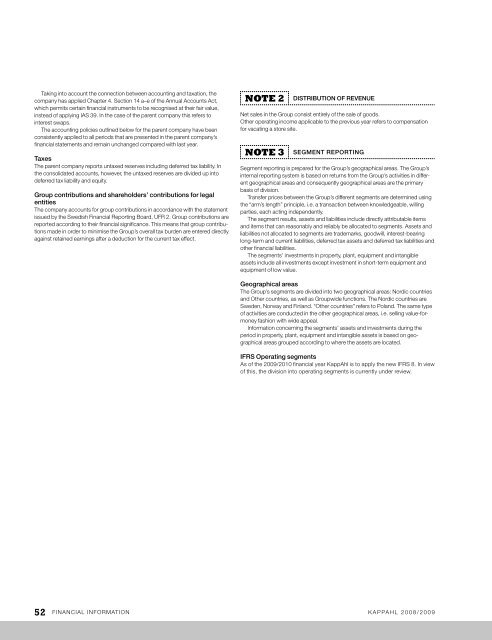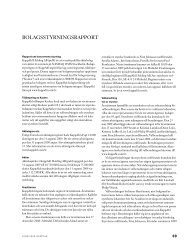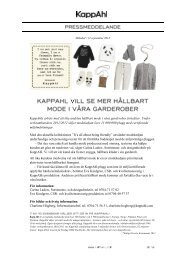We - KappAhl
We - KappAhl
We - KappAhl
Create successful ePaper yourself
Turn your PDF publications into a flip-book with our unique Google optimized e-Paper software.
taking into account the connection between accounting and taxation, the<br />
company has applied chapter 4. Section 14 a–e of the annual accounts act,<br />
which permits certain financial instruments to be recognised at their fair value,<br />
instead of applying iaS 39. in the case of the parent company this refers to<br />
interest swaps.<br />
the accounting policies outlined below for the parent company have been<br />
consistently applied to all periods that are presented in the parent company’s<br />
financial statements and remain unchanged compared with last year.<br />
Taxes<br />
the parent company reports untaxed reserves including deferred tax liability. in<br />
the consolidated accounts, however, the untaxed reserves are divided up into<br />
deferred tax liability and equity.<br />
Group contributions and shareholders’ contributions for legal<br />
entities<br />
the company accounts for group contributions in accordance with the statement<br />
issued by the Swedish financial reporting Board, Ufr 2. Group contributions are<br />
reported according to their financial significance. this means that group contributions<br />
made in order to minimise the Group’s overall tax burden are entered directly<br />
against retained earnings after a deduction for the current tax effect.<br />
Note 2 DISTRIBUTION OF REVENUE<br />
net sales in the Group consist entirely of the sale of goods.<br />
other operating income applicable to the previous year refers to compensation<br />
for vacating a store site.<br />
Note 3 SEGMENT REPORTING<br />
Segment reporting is prepared for the Group’s geographical areas. the Group’s<br />
internal reporting system is based on returns from the Group’s activities in different<br />
geographical areas and consequently geographical areas are the primary<br />
basis of division.<br />
transfer prices between the Group’s different segments are determined using<br />
the “arm’s length” principle, i.e. a transaction between knowledgeable, willing<br />
parties, each acting independently.<br />
the segment results, assets and liabilities include directly attributable items<br />
and items that can reasonably and reliably be allocated to segments. assets and<br />
liabilities not allocated to segments are trademarks, goodwill, interest-bearing<br />
long-term and current liabilities, deferred tax assets and deferred tax liabilities and<br />
other financial liabilities.<br />
the segments’ investments in property, plant, equipment and intangible<br />
assets include all investments except investment in short-term equipment and<br />
equipment of low value.<br />
Geographical areas<br />
the Group’s segments are divided into two geographical areas: nordic countries<br />
and other countries, as well as Groupwide functions. the nordic countries are<br />
Sweden, norway and finland. “other countries” refers to poland. the same type<br />
of activities are conducted in the other geographical areas, i.e. selling value-formoney<br />
fashion with wide appeal.<br />
information concerning the segments’ assets and investments during the<br />
period in property, plant, equipment and intangible assets is based on geographical<br />
areas grouped according to where the assets are located.<br />
IFRS Operating segments<br />
as of the 2009/2010 financial year Kappahl is to apply the new ifrS 8. in view<br />
of this, the division into operating segments is currently under review.<br />
52 financial information Kappahl 2008/2009





